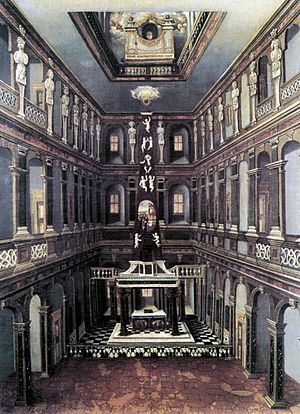Wachet! betet! betet! wachet! BWV 70 facts for kids
Quick facts for kids Wachet! betet! betet! wachet! |
|
|---|---|
| Church cantata | |

The Schlosskirche in Weimar
|
|
| Occasion |
|
| Performed | |
| Movements |
|
| Vocal | SATB choir and solo |
| Instrumental |
|
Wachet! betet! betet! wachet! (which means "Watch! Pray! Pray! Watch!") is the name of two church cantatas by Johann Sebastian Bach. A cantata is like a mini-opera or a special piece of music for a choir and orchestra. Bach first wrote a shorter version, called BWV 70a, in 1716 while he was in Weimar. He then made it longer in 1723 in Leipzig, creating BWV 70. This longer version has two parts.
Contents
Bach's Cantata: A Musical Story
How the Cantata Started
In 1714, Bach became the concertmaster (main musician and composer) at the court in Weimar. His job was to write new music, especially cantatas, for the Schlosskirche (palace church) every month.
Bach wrote the first version of this cantata in his last year in Weimar. It was for the Second Sunday of Advent. Advent is a special time before Christmas.
The words for this cantata came from a poet named Salomon Franck. Bach used five musical sections: a chorus (for the whole choir) and four arias (songs for a solo singer). He finished the cantata with a part of a hymn (a church song) called "Meinen Jesum laß ich nicht".
Bach performed this first version on December 6, 1716.
Why Bach Changed It
Later, when Bach was in Leipzig, Advent was a quiet time. No cantata music was played in church services during most of Advent. To use his music again, Bach needed to change the cantata for a different church day. He chose the 26th Sunday after Trinity. This day had a similar theme about being ready for important events.
An unknown poet helped Bach. They kept the original music and added new parts called recitatives (parts that sound like talking in music) and another hymn. This new hymn, "Freu dich sehr, o meine Seele", ended the first part of the longer cantata.
Bach performed this longer cantata for the first time on November 21, 1723. He performed it again on November 18, 1731.
Instruments and Structure
The instruments Bach used for the first, shorter cantata in Weimar are not known today.
The longer cantata (BWV 70) was written for:
- Solo singers: a soprano (high female voice), an alto (lower female voice), a tenor (high male voice), and a bass (low male voice).
- A four-part choir (soprano, alto, tenor, bass).
- Instruments: a trumpet, an oboe, a bassoon, two violins, a viola, and a basso continuo (a group of instruments that play the bass line and chords, like a cello and harpsichord).
The cantata is divided into two parts:
Part I
- Chorus: Wachet! betet! betet! wachet! (Watch! Pray! Pray! Watch!)
- Recitative (bass): Erschrecket, ihr verstockten Sünder (Be terrified, you hardened sinners)
- Aria (alto): 'Wenn kömmt der Tag, an dem wir ziehen (When comes the day on which we journey)
- Recitative (tenor): Auch bei dem himmlischen Verlangen (Even with the heavenly longing)
- Aria (soprano): Laßt der Spötter Zungen schmähen (Let the tongues of mockers revile)
- Recitative (tenor): Jedoch bei dem unartigen Geschlechte (Yet with the unruly generation)
- Chorale: Freu dich sehr, o meine Seele (Rejoice greatly, O my soul)
Part II
- Aria (tenor): Hebt euer Haupt empor (Lift up your heads)
- Recitative (bass): Ach, soll nicht dieser große Tag (Ah, should not this great day)
- Aria (bass): Seligster Erquickungstag (Most blessed day of refreshment)
- Chorale: Nicht nach Welt, nach Himmel nicht (Not for the world, not for heaven)
The Music's Story
The opening chorus, "Wachet! betet! betet! wachet!", is very exciting. Bach used a special musical form called da capo (meaning "from the beginning") where a section is repeated. The trumpet plays a special "wake-up" call, and all the other instruments and voices join in. The choir sings short, urgent calls of "Wachet!" (Watch!) and then longer, sustained sounds for "betet!" (Pray!).
All the instruments play along with the recitative (the talking-like part). The music helps to show different feelings: the fear of sinners, the calm of those who are ready, the idea of the world ending, and the worry of those who will be judged.
The first part of the cantata ends with the hymn "Freu dich sehr, o meine Seele". It's sung by four voice parts.
In the second part, a recitative (movement 9) starts very fast and intense, like a "last stroke." The trumpet plays a tune from another hymn, "Es ist gewisslich an der Zeit" (Indeed, the time is here). This hymn was often used during difficult times, like the Thirty Years' War. This recitative ends with a long, flowing melody on the words "Wohlan, so ende ich mit Freuden meinen Lauf" (Therefore, I will end my course with joy).
Right after this, the bass aria begins very slowly and calmly. It's a quiet moment about Jesus leading to a peaceful place. The cantata finishes with a rich and beautiful hymn. The upper strings (violins and viola) play their own special parts, creating a "halo" sound around the voices.
See also
 In Spanish: Wachet! betet! betet! wachet!, BWV 70 para niños
In Spanish: Wachet! betet! betet! wachet!, BWV 70 para niños

